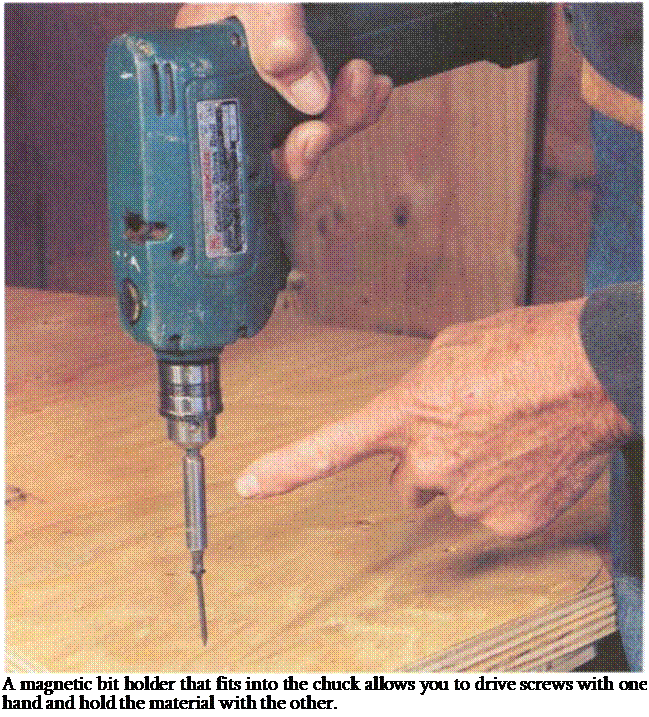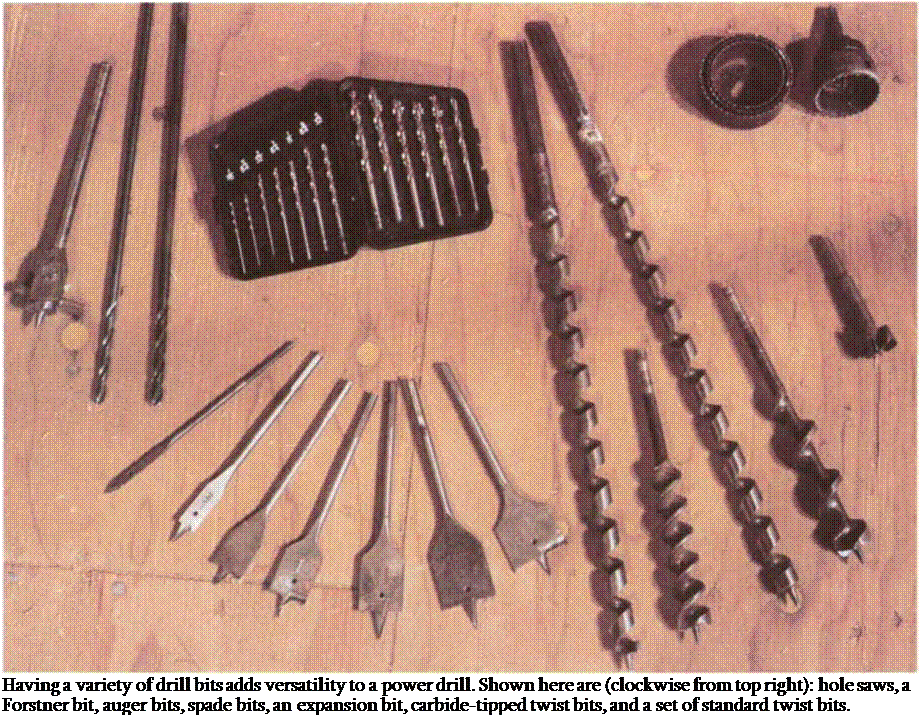DRILLS
I remember making hole after hole with a hand-powered brace and bit in the early ’50s. I still have one hanging on the wall of my shop. Drilling bolt holes by hand in 2×6 sill plates was easy. But drilling a 1-in. bolt hole in a thick, solid beam took effort. Even with sharp bits, hand drilling was time-consuming. Today, a power drill fitted with the proper bit can drill the toughest hole in seconds. The power drill is a versatile tool. It makes holes in all sorts of material and can even be used for driving screws and for mixing paint and drywall compound.
|
Drill safety
• For clean, easy cuts, use sharp bits.
• Don’t force the drill. Let it cut at its own pace. When drilling into hard wood, coat the bit with wax or soap to make drilling easier. Use low speeds for drilling into steel and lubricate the bit with oil to reduce friction and heat buildup.
• Treat any drill with respect, just as you would a circular saw. Drills have a lot of torque (turning power). If a bit gets hung up on a hard knot or a nail, all the power of the drill is transferred to its handle, which will give your arm a powerful (and potentially wristbreaking) twist.
• When drilling into heavy or thick material, use two hands to hold the drill steady. When drilling with an auger bit or with a powerful drill, use the side handle. The torque can be so great that it is hard to hold these tools with one hand.
• Work with your feet apart and your body in a well – balanced position. Be especially careful when drilling from a ladder. Make sure the ladder is stable and that you are not in an awkward position.
• Make sure what you are drilling is secure. If it is not stationary, clamp the workpiece to a sawhorse or to a workbench. Don’t try to hold the piece to be drilled with your hands. It’s too easy to lose control of the piece and injure yourself.
There are three basic things you should consider when buying a drill: its size, type, and chuck style. Drill sizes are dictated by the largest bit shank (the shaft of the bit) that will fit into the chuck (the jaws that hold bits). Common drill sizes are 1/4 in., 3/s in., and 1/2 in., and most carpenters own both 3/s-in. and У2-ІП. drills. My3/s-in. drill is reversible (meaning I can change the direction the bit rotates) and has a variable-speed switch. These two qualities allow me to use the drill for both driving and removing screws. Even better, when a bit gets stuck, I can switch to reverse and back it out of the hole. I use my powerful Уг-іп. drill when I need to drill larger holes (for example, for bolts or locksets). A handy accessory for а Уг-іп. drill is a side handle, which allows you to hold the drill securely with two hands when drilling large holes.
There are different types of drills. Some have a pistol grip, while others have two handles. Some drill straight on, while others drill at a right angle (see the photo on the facing page). The type of drill you need depends on the work you do.
I use my Уг-іп. right-angle drill in tight places (for example, in stud and joist bays) and hold on tight when I’m using it. This tool has a lot of power. The hammer drill is a variation of the standard drill. This tool moves a drill bit in a circular and up and down motion at the same time. You can drill through concrete or other masonry materials like magic.
Although many drills have chucks that are tightened around a bit’s shank using a key, most carpenters now prefer drills with keyless chucks. That means the chuck is tightened by hand. Keyless chucks are fine for most work and allow for quick bit changing. But for heavy – duty drilling, you’ll still need a keyed chuck to keep the bit from slipping.
In general, buying drill bits in sets is less expensive than buying them individually.
I use standard twist bits (from Vm in. to Vi in.) to drill holes in wood, and hardened or carbide-tipped bits to drill holes in metal, masonry, tile, and glass.
bottoms, smooth sides, and a clean top edge that can later be filled with a wood plug.
Holes for door locksets (which are typically 2[3]/s in. dia.) can be drilled with a hole saw. Available in sizes ranging up to 6 in., hole saws (which are bits that have teeth around the perimeter like a saw) can have bimetal teeth for cutting large holes, not only in wood but also in light metals, plastics, and fiberglass.

Auger bits are handy for cutting holes through thick material, such as бхб beams. They are self-feeding, meaning that they pull themselves into the hole, and don’t require a lot of force on the part of the drill operator. Adjustable expansion bits can cut holes of varying size.
For finish work, it’s often a good idea to countersink screws (putting the screw head below the finish surface) using a countersink bit. This type of bit has a
beveled face that makes the screw hole larger at the top to fit the head of a wood screw.
For driving screws, every carpenter carries different screwdriver bits. While you’ll still occasionally come up against a slotted screw, most screws on a construction site have a Phillips head. This configuration keeps the bit centered on the screw and provides better purchase, perfect for setting screws with a drill or screw gun. A useful accessory for driving screws is a magnetic bit holder, which
fits into the drill chuck to hold screwdriver bits (see the photo on p. 53). This setup makes it easier to drive screws with one hand and change bits quickly.








Leave a reply